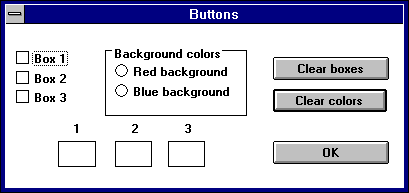
Using Buttons that Are Not Owner-Drawn
The example in this section is the window procedure for a dialog box, as shown in the following illustration.

The check boxes and radio buttons in the Buttons dialog box are automatic. The check boxes are three-state. The Clear colors push button is a default push button. The check boxes, radio buttons, and push buttons are defined in the header file of the application, as follows.
#define IDB_BOX1 101 // first check box
#define IDB_BOX2 102 // second check box
#define IDB_BOX3 103 // third check box
#define IDB_REDBACK 104 // top radio button
#define IDB_BLUEBACK 105 // bottom radio button
#define IDB_CLEARBOXES 107 // top push button
#define IDB_CLEARBACK 108 // bottom push button
HBRUSH hbrRed, hbrBlue, hbrWhite;
BOOL fRedBack, fBlueBack, fClearColor; // background-state flags
Note that it is not necessary to define IDOK, the identifier for the OK push button.
In the following window procedure, the WM_CTLCOLORDLG message notifies the application that the dialog box is about to be drawn. If the user presses the Clear colors button (signified by the fClearColor flag), the procedure uses the SendDlgItemMessage function to uncheck the check boxes and radio buttons. The BN_CLICKED notification message contains the identifiers of the buttons.
LRESULT APIENTRY ButtonProc(hDlg, message, wParam, lParam)
HWND hDlg; // window handle of dialog box
UINT message; // type of message
UINT wParam; // message-specific information
LONG lParam;
{
LRESULT lState;
switch (message) {
case WM_INITDIALOG:
hbrRed = CreateSolidBrush(RGB(255, 0, 0));
hbrBlue = CreateSolidBrush(RGB(0, 0, 255));
hbrWhite = GetStockObject(WHITE_BRUSH);
return TRUE;
case WM_CTLCOLORDLG:
if (fRedBack) {
fRedBack = FALSE;
return (LRESULT) hbrRed;
}
else if (fBlueBack) {
fBlueBack = FALSE;
return (LRESULT) hbrBlue;
}
else if (fClearColor) {
fClearColor = FALSE;
// Uncheck all check boxes and radio buttons.
SendDlgItemMessage(hDlg, // window handle
IDB_BOX1, // button identifier
BM_SETCHECK, // message
0, // check state unchecked)
0); // must be zero
SendDlgItemMessage(hDlg, IDB_BOX2,
BM_SETCHECK, 0, 0);
SendDlgItemMessage(hDlg, IDB_BOX3,
BM_SETCHECK, 0, 0);
SendDlgItemMessage(hDlg, IDB_REDBACK,
BM_SETCHECK, 0, 0);
SendDlgItemMessage(hDlg, IDB_BLUEBACK,
BM_SETCHECK, 0, 0);
}
return (LRESULT) hbrWhite;
case WM_COMMAND:
if (wParam == IDOK) {
EndDialog(hDlg, TRUE);
return TRUE;
}
if (HIWORD(wParam) == BN_CLICKED) {
switch (LOWORD(wParam)) {
case IDB_BOX1:
// Retrieve the state of the
// check box.
lState = SendDlgItemMessage(
hDlg, IDB_BOX1, BM_GETSTATE,
0, 0);
// The box-painting function is
// application defined.
BoxPainter(
hDlg, // window handle
1, // box to paint
lState); // state of box
break;
case IDB_BOX2:
lState = SendDlgItemMessage(
hDlg, IDB_BOX2, BM_GETSTATE,
0, 0);
BoxPainter(hDlg, 2, lState);
break;
case IDB_BOX3:
lState = SendDlgItemMessage(
hDlg, IDB_BOX3, BM_GETSTATE,
0, 0);
BoxPainter(hDlg, 3, lState);
break;
case IDB_REDBACK:
fRedBack = TRUE;
InvalidateRect(hDlg, NULL,
TRUE);
break;
case IDB_BLUEBACK:
fBlueBack = TRUE;
InvalidateRect(hDlg, NULL,
TRUE);
break;
case IDB_CLEARBACK:
fClearColor = TRUE;
InvalidateRect(hDlg, NULL,
TRUE);
break;
case IDB_CLEARBOXES:
BoxPainter(hDlg, 4,
(LRESULT) 0);
break;
}
}
case WM_DESTROY:
DeleteObject(hbrRed);
DeleteObject(hbrBlue);
// Do not delete hbrWhite, because it is a
// stock object.
break;
}
return FALSE; // did not process a message
UNREFERENCED_PARAMETER(lParam);
}